“And rest vanished as Nyarlathotep went because the little hours were rent with nightmare screams.” The entity known as Nyarlathotep wields such power. H.P. Lovecraft, the creator of contemporary horror, first saw the monster he later named Nyarlathotep in his nightmares when he was ten years old, and credited it as the inspiration for the now-famous entity in Lovecraftian fiction that acts as the mythos’ major nemesis.
Nyarlathotep is a fictional character created by H. P. Lovecraft. The figure is a malignant deity in the Cthulhu Mythos, a shared universe. In Lovecraft’s prose poem, he initially appeared “Nyarlathotep ” was first mentioned in Lovecraft’s and other writers’ works in 1920.
He also appeared in the 1936 short story The Haunter of the Dark, and he reappeared as the main antagonist in the 1943 fantasy novella The Dream-Quest of Unknown Kadath. He appears in more H.P. Lovecraft writings than any other deity, and he is unquestionably the most terrible and vile being in the entire mythos.
He is a shape-shifting agent of chaos, disaster, and lunacy who serves the other Outer Gods, especially his father, Azathoth, the Blind Idiot God, to whom he is faithful, carrying out his orders without debate as his messenger and emissary, but he enjoys manipulating his master on occasion. He is claimed to visit Earth on a regular basis and delights in driving the weaker members of society insane and causing them to suffer, with humans being his primary target.
He spends all his time influencing and tricking humans, or driving them insane, for his own cruel pleasure. He is thought to be the god who will annihilate the Earth. While we recognize that a monster like Nyarlathotep is inconceivable to humanity as a whole, we will do our best to convey everything we know about this malevolent being today.
Keep watching to learn more!
Who Is Nyarlathotep?
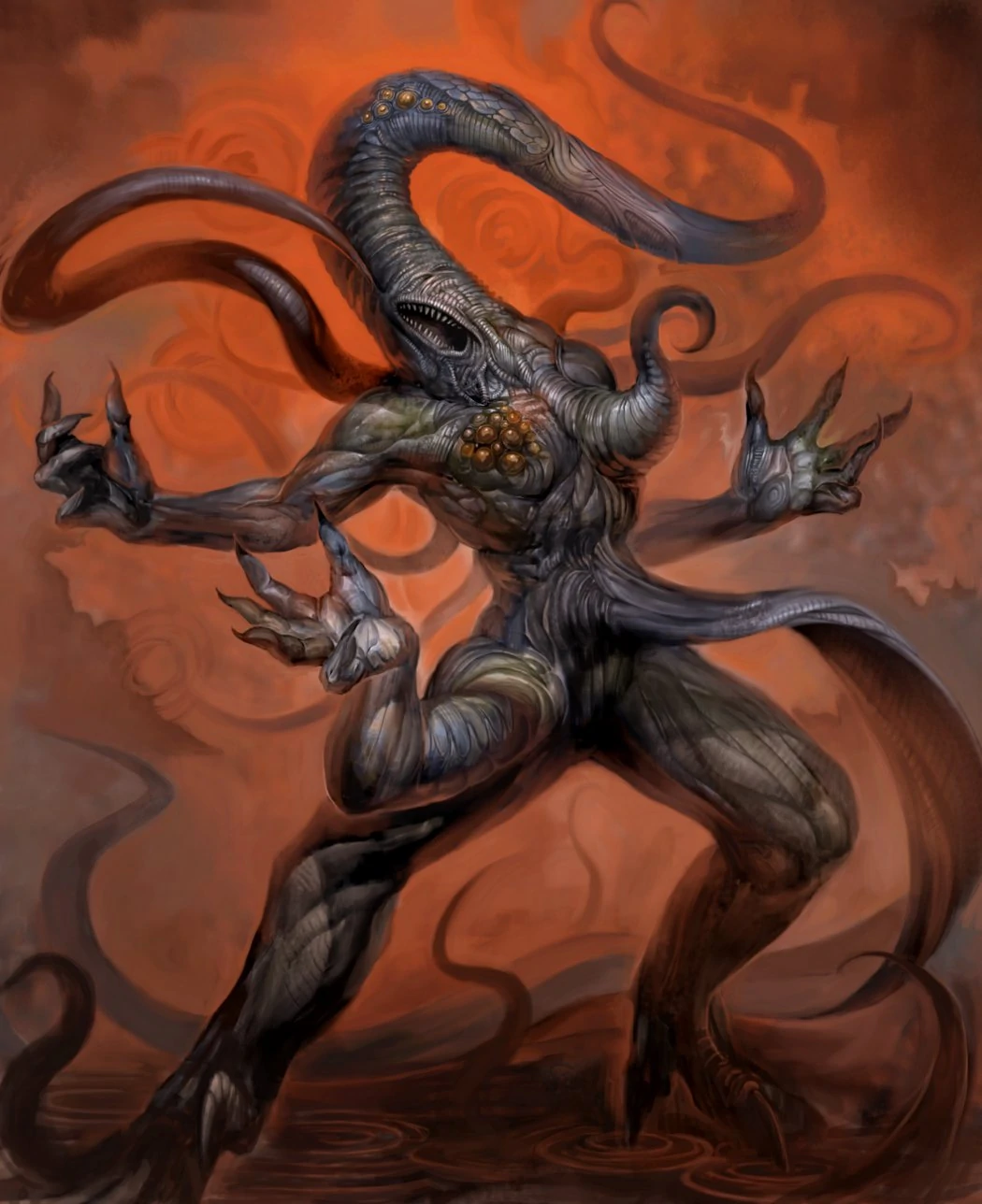
This evil outer god is prominent in Lovecraftian stories and this is his story. Nyarlathotep initially appears in Lovecraft’s eponymous story, where he is characterized as a “tall, swarthy figure” who looks like an Egyptian Pharaoh. In this narrative, he travels the globe, attracting legions of admirers with his displays of unusual and supposedly supernatural instruments, including the story’s narrator.
These followers lose consciousness of the world around them, and the reader gets a sense of the world’s entire collapse through the narrator’s increasingly questionable statements. The story concludes with the narrator serving as part of Nyarlathotep’s army of servants. The reader gets a sense of the world’s impending collapse through the narrator’s increasingly untrustworthy accounts.
He is characterized physically as a tall, slender man with a dead black complexion but no evidence of negroid features, completely devoid of hair and beard, and dressed in a shapeless robe of some heavy black cloth as his only garment. Because of the table and bench, his feet were indistinguishable, but there was a clicking every time he changed positions, so he must have been shod. The man didn’t say anything and his modest, regular features were devoid of expression.
It is important to also note that he is the spawn of Azazoth, the Blind Idiot God himself, and is also an outer God in his own right. The Cthulhu Mythos has a number of cosmically significant entities known as the Outer Gods. They are generally found beyond the bounds of Earth and the solar system, exerting their effect from beyond the solar system.
Some Outer Gods, on the other hand, have made Earth their home. They resemble the Gnostic idea of the “Demiurge,” a malignant creator functioning in an unconscious and warped mimic of the “Divine Will” in the real universe. It’s also known as “Yaldabaoth,” a name that doesn’t seem out of place in the Mythos and may have influenced Yog-Sothoth’s name.
Nyarlathotep is distinct from and can be separated from the other Mythos gods in a variety of respects. Most of the Outer Gods, like Yog-Sothoth and Azathoth, are exiled to the stars, and most of the Great Old Ones, like Cthulhu, are asleep and dreaming; Nyarlathotep, on the other hand, is active and frequently wanders on the Earth in the guise of a human being, generally a tall, skinny, joyful man. He has “a thousand” more forms and manifestations, many of which are said to be terrifying and sanity-destroying.
The majority of the Outer Gods have their own cults serving them, but Nyarlathotep appears to serve as He serves various cults and looks after their affairs while the other Outer Gods are away. The majority of Outer Gods speak weird alien languages, however, Nyarlathotep speaks human languages and may easily pass for a human if he so desires.
Finally, while the majority of them are all-powerful but appear to lack a clear purpose or plan, Nyarlathotep appears to be purposefully dishonest and manipulative, even employing propaganda to attain his objectives. He is arguably the most human-like of the Outer Gods in this way.
Nyarlathotep is the “messenger, heart, and soul” of the Outer Gods, as well as their “immemorial figure of the deputy or messenger of hidden and terrifying forces.” He is also Azathoth’s servant, and he promptly performs his fitful, spastic wants. Unlike the other Outer Gods, Nyarlathotep considers spreading lunacy to be more vital and delightful than death and destruction. Some speculate that he will extinguish the human species and even the entire planet.
Despite the fact that Nyarlathotep appears in only four stories and one sonnet, which is more than any other Great Old One or Outer God, his name is mentioned in several others. This deity’s name is especially notable for the Egyptian suffix hotep, which lends it an Egyptian flavor.
Nyarlathotep is the major enemy of the Cthulhu Mythos since he is H.P. Lovecraft’s most used deity and has appeared in more stories than any other character. Azathoth, or even Yog-Sothoth, or even Cthulhu, is thought to fulfill the role of the main antagonist but that title goes to Nyarlathotep. Despite working for Azathoth, Nyarlathotep is the true main antagonist, as he is clearly more malevolent and, in certain tales, has intentions to usurp him.
Nyarlathotep is the most malevolent of the Outer Gods in the mythos, but he may not be as strong as Azathoth or Yog-Sothoth. This could be owing to his ability to comprehend human morality, emotion, and even speech, something Azathoth is never supposed to possess. In addition to being more malevolent, Nyarlathotep is also more human than any other God in the mythos, suggesting that Lovecraft was reflecting on humanity’s evil nature.
He enjoys driving people insane and finds it more pleasurable than simply killing and destroying them, and he is, as previously established, a more human-like evil than the other Outer Gods. Nyarlathotep uses deception, manipulation, and even propaganda to achieve his objectives, and mingles with humanity to seal their doom.
These characteristics, combined with his ability to freely walk among mortal life, may make Nyarlathotep the most unpleasant and terrifying of all Lovecraftian monsters, as he averts their unknowable and amoral nature, and some have speculated that Nyarlathotep maybe the creature who will ultimately destroy the world.
Nyarlathotep Family Tree
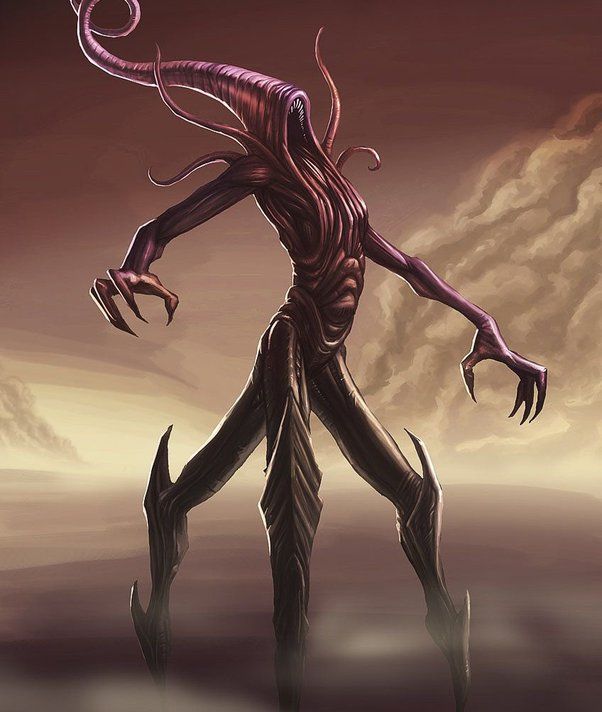
Like most outer gods, great old ones and deep ones in the Lovecraftian and Cthulu mythos, most of these unfathomable and inherently evil entities are related. As far as the familial relations of Nyarlathotep go, he is the offspring of Azathoth himself. Due to being the son of the God who is said to be at the center of our universe and in whose dreams all of life is said to reside, Nyarlathotep enjoys powers and importance unlike any other.
This is further enhanced because of the fact that he also carries out all of Azazoth’s orders, whims, and fancies. Bärkatlànm, the Darkness, and the Nameless Mist are his siblings which makes them an incredibly powerful family. Though Nyarlathotep frequently interferes with mortal affairs at will, he serves Azathoth as his messenger and as the soul of the Outer Gods.
He is the messenger for the other Outer Gods and appears to not be solely faithful to any one of them, instead of serving them all in some way, however, he is claimed to be especially loyal to Azathoth, whose wishes he will carry out without hesitation.
As far as his own family and offsprings go, Nyarlathotep would later mate with Yhoundeh and give birth to his sons Ugga-Naach and the Abominations of the Ancients through a rite in which Nyarlathotep raped a woman who subsequently gave birth to his children. As evil as evil goes, Nyarlathotep surely lives up to all his descriptions.
How They Compare Various forms of Nyarlathotep In the Cthulhu Mythos
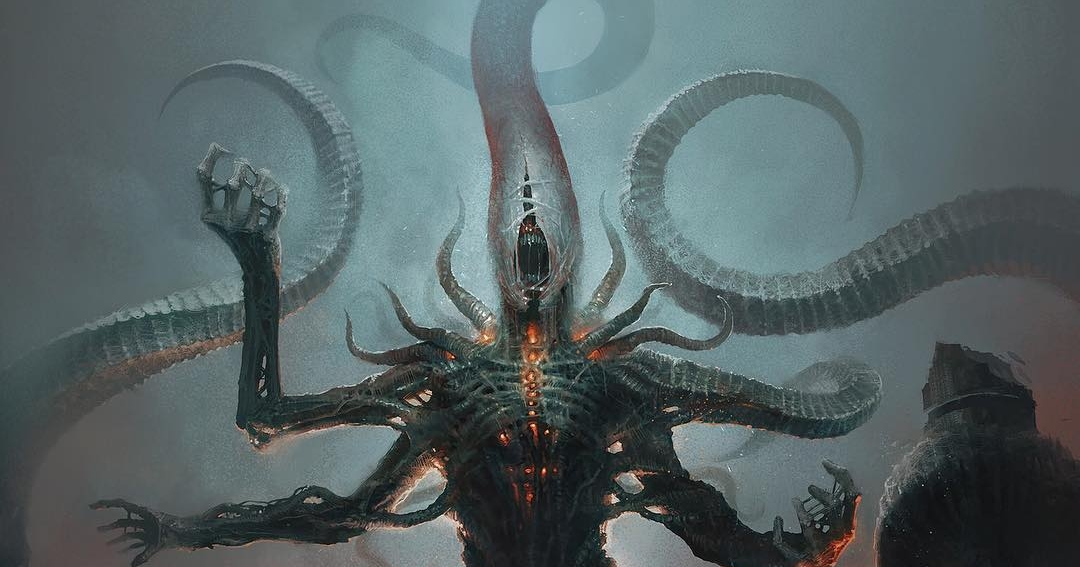
In this section, we will see how Nyarlathotep compares, to the other gods and also, how he compares to different forms of himself. Beyond the ultimate gate, the Outer Gods can be found in Azathoth’s court. They defy all notions of space and time. They are everywhere and nowhere at the same time.
All movement and position are characteristics of a reality that is only an atom in the genuine infinite of the Outer Gods. Similarly, power is a human concept that, like all other archetypes except the Outer Gods, has been transcended. Trying to apply a lowly term like power to the Outer Gods is equivalent to trying to apply fundamental elements of matter and energy to conceptual existence.
The Outer Gods are composed of “formless chaos,” transcending qualifiers and “forms.” They are unaffected by displays of power. Nyarlathotep’s might does not allow him to smash all of infinite physical reality in the same way that humans can crush an atom. His is the Outer Gods’ strength, which has no physical or even intellectual bounds.
Nyarlathotep is best known for his multiple incarnations in terms of powers. In the canonical Cthulhu Mythos, he is only seen in the form of avatars and is never truly seen. It has been reported that he governs the Earth with 1,000 avatars and that he has a vast number of them throughout his existence.
It is uncertain if his actual self possesses larger versions of each of his avatars’ talents, but at the very least he possesses the same skills as they do as Nyarlathotep’s parts. The Black Pharaoh, who previously appeared on Earth, is one of his avatars. Peasants prostrated themselves before him when he arrived, though they couldn’t explain why. His presence resulted in agitation, insomnia, and nightmares.
He twisted a metropolis and caused distortions in it, producing madness, and displaying images of the inconceivable beyond space and time, as well as the future. He also seemed to have the ability to make individuals vanish. He also appears in Yuggoth’s Fungi, where he shows visions of the future in which he reduces the Earth to dust and blows it away.
This could be the same avatar Nyarlathotep uses in Unknown Kadath’s Dream-Quest. Nyarlathotep demonstrated his ability to materialize in both physical and mental realms by appearing in the dreamlands. The “Black Man of the Witch Cult,” a fully black-skinned man who resembles the Christian Devil and offers magical powers to New England witches, is one of Nyarlathotep’s avatars.
The Haunter in the Darkness was another Nyarlathotep avatar, a three-eyed being of pure darkness from beyond space and time that could bestow forbidden knowledge in exchange for horrible sacrifices and had an odd aversion to light.
What Make Nyarlathotep an Outer God
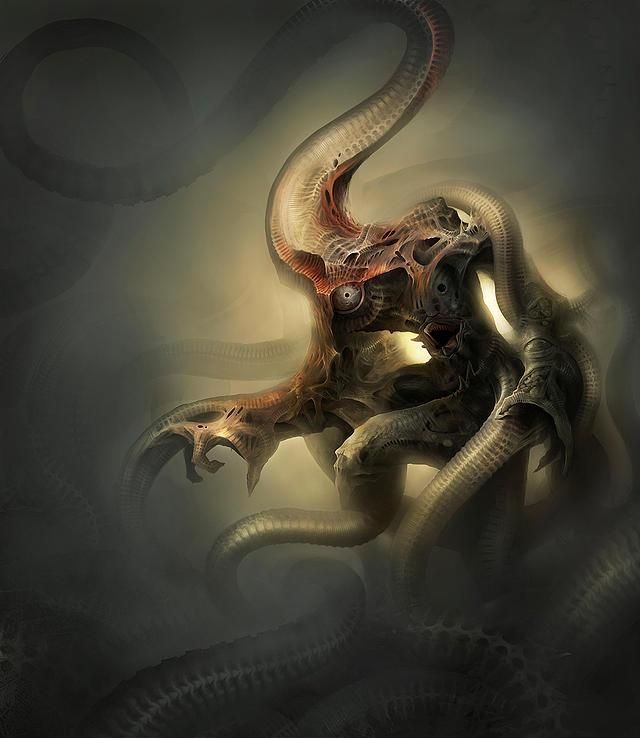
While not as powerful as his creator Azathoth or the cosmic entity Yog-Sothoth, Nyarlathotep is nevertheless an Outer God in his own right, immortal and tremendously powerful while also being extremely difficult to comprehend. Nyarlathotep is said to be able to use cosmic and demonic mystic forces to produce a variety of effects on an undefined scale.
He has the ability to materialize as a large number of different avatars. While all are powered by the god’s near-limitless intelligence, each avatar differs drastically in look, power, and purpose. Some avatars are venerated as separate individuals, with followers ignorant that they are only a small component of a much larger being.
He can also shapeshift and take on the appearance of a human man. His sheer presence, like that of Cthulhu, causes lunacy and insanity in mortals like humans, and he can speak with them via telepathy. He can also freely wander across all planes of reality and lives beyond the concept of “archetypal infinity.”
When it comes to flaws, Nyarlathotep’s avatars have flaws that are unlikely to be transferred to his main self. Nyarlathotep’s main self is confined by the will of his master Azathoth, whom he despises. He’s also sadistic, which could be a flaw, though it’s not apparent. However, no real weakness is known because no one is dumb enough to go up against him in the first place.
Nyarlathotep Has Been Referenced In Countless Forms Of Media
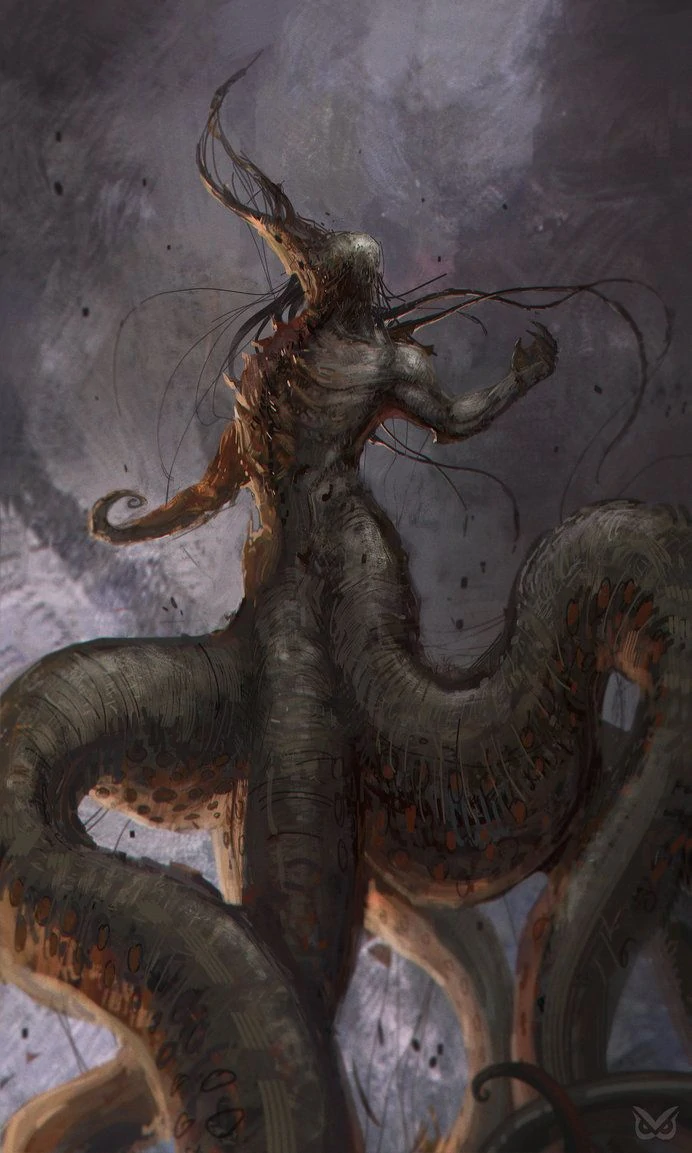
Nyarlathotep has been referenced or emulated in many different forms of media whether it be books or movies or video games. His characterization as one of the true avatars of evil makes him a favorite pick when it comes to horror media and references. He is a recurring demon and villain in the Shin Megami Tensei series, most notably as the main antagonist of the first and second Persona games.
M, a prominent character in the visual novel Shikkoku no Sharnoth who goes by the codename James Moriarty at first, is revealed to be a manifestation of Nyarlathotep near the end of the narrative. Nyarlathotep is also the primary enemy in the story Johannes Cabal: The Fear Institute and a boss in the game Cthulhu Saves the World.
Because of his humanoid look and sadistic goals, Nyarlathotep has been linked to the Slender Man, who shares the same name: “G’hor Nyarlathotep,” as well as being the main antagonist and final boss in the 2017 indie game Sundered.
The last boss of the 2018 FPS indie game DUSK is Nyarlathotep. Nyarlathotep, the last boss in Persona 2: Innocent Sin, is also Fake Kashihara. The main adversary in Stephen King’s novel Needful Things, Leland Gaunt, is suggested to be an avatar of Nyarlathotep.
Nyarlathotep and Sauron from Tolkien’s Middle-earth legendarium are supposed to be the same entity in Edward M. Erdelac’s Merkabah Rider book series. One of the Tree Creatures from the Hellboy reboot in 2019 looks a lot like Nyarlathotep. Nyarlathotep also appears as one of the SCP-4315-2-entities in the SCP Foundation universe. He resembles various other mythological figures, including Jeser and the Ambassador of Alaggada.
Villains that function as “agents of disorder,” such as Petyr Baelish and Joker, could also be considered Nyarlathotep’s avatars, as could legendary figures like Loki and Chernobog. Nyaruko, an anthropomorphized Nyarlathotep, is the titular protagonist of the manga Nyaruko: Crawling with Love. Nyaruko is kind and has a protective turned love relationship with the human Mahiro Yasaka, unlike other depictions of Lovecraftian terror.
The Darkest of the Hillside Thickets’ album Shadow Out of Tim features Nyarlathotep as the main antagonist. Nyarlathotep is a monster in the webcomic Lovecraft Girls – or How To Prevent The Apocalypse who is so taken with the beauty of the world that she decides to become the mayor of New England rather than destroy it. In Dragalia Lost, Nyarlathotep is a dragon who abducts individuals when it detects wickedness in their hearts, such as greed. Two Nyarlathoteps are also present, one of whom is the major opponent of the Accursed Archives event.
With that, we come to the end of this video, which Lovecraftian entity fascinates you the most? Let us know in the comments below!
